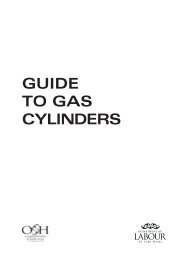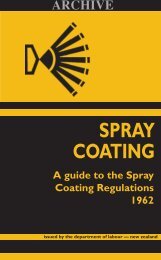Temperature in Places of Work - Health and Safety - Department of ...
Temperature in Places of Work - Health and Safety - Department of ...
Temperature in Places of Work - Health and Safety - Department of ...
Create successful ePaper yourself
Turn your PDF publications into a flip-book with our unique Google optimized e-Paper software.
TEMPERATURE <strong>in</strong> places <strong>of</strong> work<br />
Lower the air temperature through . . .<br />
Lower the humidity<br />
Some control options for<br />
Hot situations<br />
• Air condition<strong>in</strong>g. While many people see air condition<strong>in</strong>g as<br />
the ideal <strong>in</strong> summer, it also has some drawbacks. Sometimes<br />
air condition<strong>in</strong>g units do not supply enough fresh air to an<br />
area which can cause sick build<strong>in</strong>g type problems. If not<br />
ma<strong>in</strong>ta<strong>in</strong>ed properly, they can harbour fungi or bacteria that<br />
can affect the health <strong>of</strong> employees.<br />
• Ventilation. Many heat problems are a result <strong>of</strong> poor<br />
ventilation. A good ventilation system can remove hot air<br />
from a build<strong>in</strong>g. It is also good for remov<strong>in</strong>g any<br />
contam<strong>in</strong>ants from the air. New Zeal<strong>and</strong> St<strong>and</strong>ard 4303:<br />
Ventilation for Acceptable Indoor Air Quality, Table 2,<br />
recommends ventilation rates for different types <strong>of</strong> workplace.<br />
In <strong>of</strong>fices, for example, a ventilation rate <strong>of</strong> 10 litres <strong>of</strong> outside<br />
air per second, per person, is recommended. The<br />
disadvantage is that you are at the mercy <strong>of</strong> the temperature<br />
<strong>of</strong> the air you br<strong>in</strong>g <strong>in</strong> to replace what you remove.<br />
• If possible, open w<strong>in</strong>dows <strong>and</strong> doors to allow any breeze <strong>in</strong>to<br />
the work area.<br />
• Provide good extraction ventilation, especially if there is any<br />
moisture given <strong>of</strong>f <strong>in</strong> a work process.<br />
• You can use dehumidifiers to lower humidity. This is another<br />
form <strong>of</strong> air condition<strong>in</strong>g.<br />
Reduce exposure to radiant heat<br />
• Install <strong>in</strong>sulation to prevent heat radiat<strong>in</strong>g through ro<strong>of</strong>s or<br />
walls.<br />
• Use bl<strong>in</strong>ds, curta<strong>in</strong>s or reflective coat<strong>in</strong>gs on w<strong>in</strong>dows to<br />
reduce direct sunlight.<br />
• Place <strong>of</strong>fice mach<strong>in</strong>ery that produces heat <strong>in</strong> a well ventilated<br />
or isolated area.<br />
• Shield employees from any hot process.<br />
Increase air speed <strong>and</strong> movement<br />
• Increase air speed. Many <strong>of</strong>fices <strong>and</strong> factories have almost no<br />
air movement. A well-designed ventilation system should<br />
ISSUED BY THE OCCUPATIONAL SAFETY AND HEALTH SERVICE, DEPARTMENT OF LABOUR, WELLINGTON, NEW ZEALAND<br />
3730GFO DECEMBER 1997<br />
OCCUPATIONAL SAFETY<br />
& HEALTH SERVICE<br />
DEPARTMENT OF<br />
LABOUR<br />
TE TARI MAHI<br />
Information Sheet No. 6<br />
Cont<strong>in</strong>ued over





